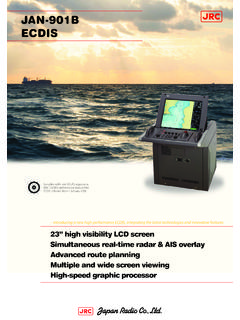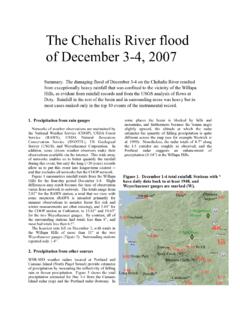Transcription of ANNUAL EVALUATION REPORT 2016 State of Texas Dr ...
1 ANNUAL EVALUATION REPORT 2016 State of Texas Dr. Arqu medes Ruiz Columbi . Active Influence & Scientific Management Cloud seeding operations 2016 began over the Texas Weather Modification Target Area in March (March 7th, first operational day for the WTWMA target area) . This ANNUAL REPORT is a compilation of the EVALUATION reports already made and published for four local projects: Panhandle, WTWMA, TPWMA, and STWMA target areas (EAA target area is included in the last one). A total of 306 clouds were seeded and identified by TITAN in 119 target area operational days. Table 1 summarizes the general figures: Table 1: Generalities First evaluated operational day: March 7th, 2016 (WTWMA). Last operational day: November 11th, 2016 (STWMA) Season: 250 days Net Number of operational days: 119. Most active period: May to September: 103 ~ 87 % of the operational days, Less active months: March: 2 ~ 2 % of the operational days November: 2 ~ 2 % of the operational days According to the daily reports, operational days were qualified as: Seventy-eight with excellent performance Twenty-eight with very good performance Twelve with good performance One with fair performance Number of seeded clouds: 306.
2 (179 small seeded clouds, 81 large seeded clouds, 46 type B seeded clouds). Missed Opportunities: none (with lifespan longer than 1 hour). 1. Small Clouds Table 2 shows the average results from the classic TITAN evaluations for the 179 small seeded clouds which obtained proper control clouds. Table 2: Seeded Sample versus Control Sample (179 couples, averages). Variable Seeded Sample Control Sample Simple Ratio Increases (%). Lifetime min min 53 (40). Area km 2 km 2 54 (39). Volume km 3 km 3 66 (42). Top Height km km 10 (3). Max dBz 3 (1). Top Height of max dBz km km 0 (-1). Volume Above 6 km km 3 km 3 85 (45). m 3 /s m 3 /s 69 (49). kton kton 166 (126). CloudMass kton kton 76 (45). 51 (56). Bold values in parentheses are modeled values, whereas is defined as the quotient of Precipitation Mass divided by Cloud Mass, and is interpreted as efficiency.
3 A total of 1181 AgI and 100 hygroscopic flares were used in this sub-sample with an excellent timing (95 %), for an effective AgI dose about 65 ice-nuclei per liter, which might have reached slightly higher levels in some individual cells. An excellent increase of 126 % in precipitation mass together with an increase of 45 % in cloud mass illustrates that the seeded clouds grew at expenses of the environmental moisture (they are open systems). and used only a fraction of this moisture for their own maintenance. The increases in lifetime (40 %), area (39 %), volume (42 %), volume above 6 km (45 %), and precipitation flux (49 %) are notable. There were slight increases in maximum reflectivity (1 %), and in top height (3 %). The seeded sub-sample seemed 56 % more efficient than the control sub-sample. Results are evaluated as excellent for this sub- sample.
4 2. An increase of 126 % in precipitation mass for a control value of kton in 179 cases means: 1 = 179 x x kton 174 951 kton 241 886 ac-f (mean layer: mm in). Large Clouds The sub-sample of 81 large seeded clouds received a synergetic analysis. In average the seeding operations on these large clouds affected 82 % of their whole volume, with a perfect timing (100 % of the material went to the clouds in their first half-lifetime). A. total of 2066 AgI and 185 hygroscopic flares were used in this sub-sample for an effective silver iodide average dose near 95 ice-nuclei per liter. Also in average, large clouds were 23 minutes old when the operations took place; the operation lasted about 36 minutes, and the large seeded clouds lived 250 minutes (4 hours and 10 minutes). Table 3 shows the corresponding results: Table 3: Large Seeded Sample versus Virtual Control Sample (81 couples, averages).
5 Variable Seeded Sample Control Sample Simple Ratio Increases (%). Lifetime 250 min 200 min 25. Area 1397 km 2 1140 km 2 23. Volume 6186 km 3 5057 km 3 22. Volume Above 6 km 2315 km 3 1897 km 3 22. 13 172 m 3 /s 9 900 m 3 /s 33. 90 942 kton 56 373 kton 61. An increase of 61 % in precipitation mass for a control value of 56 373 kton in 81 cases implies: 2 = 81 x x 56 373 kton 2 785 390 kton 2 258 951 ac-f (mean layer: mm in). 3. Type B Clouds The sub-sample of 46 type B seeded clouds also received a synergetic analysis. In average the seeding operations on these type B clouds affected 21 % of their whole volume with a quasi-excellent timing (87 % of the material went to the clouds in their first half-lifetime). A total of 1001 AgI and 82 hygroscopic flares were used in this sub- sample for an effective silver iodide average dose about 90 ice-nuclei per liter.
6 Also in average, type B clouds were 118 minutes old when the operations took place; the operation lasted about 32 minutes, and the type B seeded clouds lived 295 minutes (4. hours and 55 minutes). Table 4 shows the results: Table 4: Type B Seeded Sample versus Virtual Control Sample (46 couples, averages). Variable Seeded Sample Control Sample Simple Ratio Increases (%). Lifetime 295 min 285 min 4. Area 2102 km 2 2002 km 2 5. Volume 9130 km 3 8642 km 3 6. Volume Above 6 km 2738 km 3 2587 km 3 6. 14 438 m 3 /s 13 500 m 3 /s 7. 121 347 kton 110 372 kton 10. An increase of 10 % in precipitation mass for a control value of 110 372 kton in 46 cases implies: 3 = 46 x x 110 372 kton 507 711 kton 411 754 ac-f (mean layer: mm in). The total increase: = 1 + 2 + 3 = 2 812 591 ac-f millions ac-f (~ 790 ac-f per small storm; ~ 27 900 ac-f per large storm; ~ 8 950 per B storms).
7 4. Micro-regionalization Increases in precipitation mass were analyzed county by county in an attempt to better describe the performance and corresponding results. Table 5 below offers the details: Table 5: Results per county Panhandle Ground Water Conservation District Program County Initial Extended Acre-feet Inches rain gage %. seeding (increase) (increase) (season value) (increase). Armstrong 12 15 112 800 in Carson 9 15 117 700 in Donley 6 16 77 400 in Gray 6 20 99 800 in Potter 3 6 83 000 in Roberts 7 15 65 700 in Wheeler 2 11 52 800 in Outside 9 99 700. Sub-total 45 98 708 900 (~14 % outside the target area). Local Average (only for the bold values) in in %. 5. West Texas Weather Modification Association Program County Initial Extended Acre-feet Inches rain %. Seeding (increase) (increase) (season value) (increase).
8 Sterling 14 15 110 500 in %. Reagan 26 28 174 700 in %. Irion 19 22 147 600 in %. Tom Green 9 11 111 300 in %. Crocket 16 17 172 700 in %. Schleicher 16 18 165 900 in %. Sutton 9 11 92 800 in %. Outside TA 2 7 ~ 80 200 (~ % of the total amount). Sub-total 111 129 1 055 700 ac-f Local Average (only for the bold values) in %. 6. South Texas Weather Modification Association Program County Initial Extended Acre-feet Inches rain Gage %. Seeding (increase) (increase) (season value) (increase). Uvalde 6 10 80 500 in Bandera 3 5 38 200 in(*) Medina 8 13 43 800 in Bexar 5 11 26 400 in Fr o 8 11 40 700 in Atascosa 27 40 93 500 in(*) McMullen 9 17 73 100 in Wilson 10 18 36 600 in Karnes 21 27 48 400 in Bee 14 17 56 800 in(*) Outside 9 15 18 400 ( % of the total amount). Sub-total 120 184 556 400. Local Average in 7. Trans-Pecos Weather Modification Association County Initial Extended Acre-feet Inches rain Gage %.
9 Seeding (increase) (increase) (season value) (increase). Culberson 1 2 9 200 %. Reeves 15 17 68 900 %. Pecos 9 13 79 200 %. Ward 4 6 42 000 %. Loving 1 2 13 500 %. Outside 53 000 (~ 20 % of the total increase). (downwind effect over Winkler, Ector and Crane Counties). Sub-total 30 41 265 800. Local Average in in %. 8. Table 6: Synoptic Summary Program Initial Extended Acre-feet Increase Season rain %. seeding increase in inches in inches PGCD 45 98 708 900 in in WTWMA 111 129 1 055 700 in in STWMA 120 184 556 400 in in TPWMA 30 41 265 800 in in Totals 306 452 2 586 800 ac-f Averages in in %. Outside the target areas (downwind effect): 251 300 ac-f (~ 10 % of the total increase). Total amount of flares used: 4248 (AgI) plus 367 (Hygroscopic). 9. Final Comments 1) Results are evaluated as excellent (no miss-opportunities, 95 % average timing, 75 in/l average glaciogenic dose).
10 2) The micro-regionalization analysis showed increases per county; the average increase in precipitation, referred to an average seasonal value, was about %; a total increase of about million acre-feet should be considered as a great help to fresh water natural resources. 3) radar estimations of precipitation should be considered as measurements of trend. Nevertheless, seeding operations improved the dynamics of seeded clouds. 4) During the 2016 cloud seeding campaign in Texas , hygroscopic seeding played an important role in the operations. When possible, it is important to perform dual seeding operations in order to obtain the desire synergy. Cloud base temperature is an excellent indicator of hygroscopic seeding opportunities: cloud bases colder than about 10 C may indicate the presence of too many CCN (cloud condensation nuclei) and the needs to potentiate the droplet collision-coalescence mechanism for the formation of precipitation.




